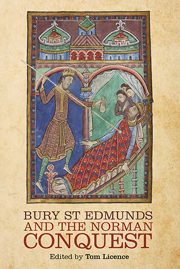Book contents
- Frontmatter
- Contents
- LIST OF ILLUSTRATIONS
- LIST OF MUSIC EXAMPLES
- LIST OF CONTRIBUTORS
- ACKNOWLEDGMENTS
- LIST OF ABBREVIATIONS
- Introduction
- 1 The Abbey and the Norman Conquest an Unusual Case?
- 2 Charters and Influences from Saint-Denis c. 1000–1070
- 3 The Abbey's Armoury of Charters
- 4 The Women of Bury St Edmunds
- 5 Baldwin's Church and the Effects of the Conquest
- 6 New Light on the Life and Work of Herman the Archdeacon
- 7 The Cult of St Edmund
- 8 St Edmund Between Liturgy and Hagiography
- 9 Books and their Use Across the Conquest
- 10 An Eleventh-Century Bury Medical Manuscript
- 11 Medicine at Bury in the Time of Abbot Baldwin
- 12 Medicine After Baldwin: The Evidence of BL, Royal 12. C. xxiv
- Index
5 - Baldwin's Church and the Effects of the Conquest
Published online by Cambridge University Press: 05 August 2014
- Frontmatter
- Contents
- LIST OF ILLUSTRATIONS
- LIST OF MUSIC EXAMPLES
- LIST OF CONTRIBUTORS
- ACKNOWLEDGMENTS
- LIST OF ABBREVIATIONS
- Introduction
- 1 The Abbey and the Norman Conquest an Unusual Case?
- 2 Charters and Influences from Saint-Denis c. 1000–1070
- 3 The Abbey's Armoury of Charters
- 4 The Women of Bury St Edmunds
- 5 Baldwin's Church and the Effects of the Conquest
- 6 New Light on the Life and Work of Herman the Archdeacon
- 7 The Cult of St Edmund
- 8 St Edmund Between Liturgy and Hagiography
- 9 Books and their Use Across the Conquest
- 10 An Eleventh-Century Bury Medical Manuscript
- 11 Medicine at Bury in the Time of Abbot Baldwin
- 12 Medicine After Baldwin: The Evidence of BL, Royal 12. C. xxiv
- Index
Summary
An accurate picture of the architectural history of Abbot Baldwin's church began to emerge already in the middle of the nineteenth century, as for example with Graham Hills's study of 1865. The first person to make sense of the remains on the site as a whole was Arthur Whittingham, with the research he published in the early 1950s, and many aspects of the subject were investigated further at the conference of the British Archaeological Association of 1994, organized by Antonia Gransden. In the present essay I want to examine three things: the contrast between the Norman church and its Anglo-Saxon predecessors; how relations between the abbey and the diocese in the late eleventh century may be reflected in changes in the plan of the church; and the relationship between the plans of the abbey and the town.
The Contrast between the Norman Church and its Anglo-Saxon Predecessors
According to Abbo of Fleury, when St Edmund's body arrived in Beodricesworth (before c. 950), the faithful of the vill built a very large wooden church to receive it. Nothing is recorded of its shape. Cnut and Emma supported the building of a church which was begun about 1020 and consecrated in 1031 or 1032, the new work, according to Herman, being carried out in stone.
- Type
- Chapter
- Information
- Bury St Edmunds and the Norman Conquest , pp. 74 - 93Publisher: Boydell & BrewerPrint publication year: 2014

